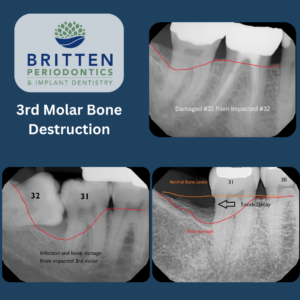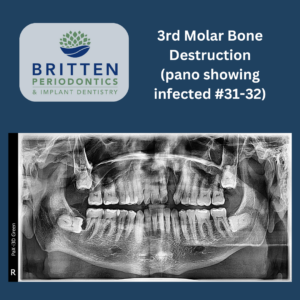Why You Should Consider Having Your Wisdom Teeth Removed




In the ever-evolving landscape of dental care, advancements in periodontal surgery have transformed the way we approach the treatment of gum disease and related issues. From innovative technologies to refined surgical techniques, these advancements offer new hope for patients seeking improved oral health and wellbeing.
One of the most significant advancements in periodontal surgery is the widespread adoption of laser therapy. Laser-assisted procedures offer several advantages:
Guided tissue regeneration (GTR) is another advanced technique revolutionizing periodontal surgery. This procedure involves the use of barrier membranes to promote the regeneration of lost gum and bone tissues, ultimately restoring both function and aesthetics. Key benefits of GTR include:
Dental implant surgery has undergone remarkable advancements in recent years, revolutionizing the way we restore missing teeth and rejuvenate smiles. From improved materials to cutting-edge techniques, these innovations have advanced the safety, effectiveness, and aesthetics of dental implant procedures, offering new hope to patients seeking durable and natural-looking teeth replacements. Some of these advances include:
Advanced techniques in periodontal surgery have transformed periodontal treatment with highly predictable, minimally invasive, and aesthetic treatment options for patients. As technology continues to evolve, the future holds even greater promise for periodontal and implant dentistry, paving the way for continued improvements in patient care and satisfaction.
Gum health is often overlooked, yet it plays a crucial role in our overall well-being. Periodontal disease, commonly known as gum disease is a prevalent condition that affects millions of people worldwide. Periodontal disease is a chronic inflammatory condition that affects the tissues surrounding the teeth. It typically begins with gingivitis, characterized by red, swollen gums that bleed easily. Without proper treatment, gingivitis can lead to periodontitis, where the infection spreads deeper into the gums and bone supporting the teeth. This can eventually lead to tooth loss if left untreated.
Some Risk Factors for Periodontal Disease
Signs and Symptoms
Complications of Untreated Periodontal Disease
Prevention and Treatment:
If diagnosed with gum disease, your dentist may recommend professional cleanings, scaling and root planing, antibiotic therapy, or surgical interventions to restore gum health and prevent further damage.
Gum health is a cornerstone of overall wellness, and understanding periodontal disease is essential for maintaining a healthy smile and body. By prioritizing oral hygiene, adopting healthy lifestyle habits, and seeking timely dental care, you can safeguard your gums and reduce your risk of gum disease and its associated complications. Remember, your smile is worth protecting, so invest in your gum health today for a brighter tomorrow!
The evidence is overwhelming that smoking contributes to periodontal disease and that continued smoking results in a reduced response to periodontal treatment. There is a greater amount of bone loss around teeth in smokers and individuals who smoke are more likely to lose teeth than nonsmokers. It is reported that more than half of advanced gum disease can be linked to tobacco use.
Nicotinic Stomatitis
In nicotinic stomatitis, the hard palate (roof of the mouth- pictured above) appears white instead of pink, and numerous, small raised areas with red centers are found throughout the palate. These red areas are irritated minor salivary glands whose duct openings are inflamed in response to the heat from tobacco products. This lesion is most commonly seen in older male tobacco users who smoke pipes but it also can be found in cigar and cigarette smokers.
There is an increased risk for cancer of the tonsils, posterior mouth, and lungs in individuals who develop nicotinic stomatitis from their tobacco use. However, if the individual stops their tobacco use, the appearance of hard palate typically returns to normal within a few weeks.
When recession of the gum tissue occurs, the body loses a natural defense against both bacterial penetration and trauma. When gum recession is a problem, gum reconstruction using grafting techniques is an excellent option.
When there is only minor recession, some healthy gum tissue often remains and protects the tooth, so that no treatment other than modifying home care practices is necessary. However, when no firm gum tissue remains, this leaves the roots of the teeth and the underlying bone relatively unprotected, which could result in root sensitivity, bacterial penetration, decay and even loss of teeth.
A gingival graft is designed to address these problems. A thin piece of tissue is taken from the roof of the mouth or gently moved over from adjacent areas to provide a stable band of attached gum tissue around the tooth. The gingival graft may be placed in such a way as to cover the exposed portion of the root, however, the main objective is to reestablish the protective barrier or layer of the gum around the tooth. Occasionally, the patient may need multiple procedures to achieve the ideal amount of root coverage.
Dr. Britten has trained in the latest minimally invasive techniques of gum grafting and can often perform the entire procedure through a pinhole incision.
Here at Britten Periodontics, as a periodontist and dental implant specialist, Dr. Todd Britten wants to ensure his dental implant patients have the best care possible using the latest technology available. By using advanced 3-D technology, Dr. Britten explains that he is able to obtain and review high-quality images for dental implant planning and even create a 3-D printed surgical guide.
When a patient is ready for a dental implant, Dr. Britten explains the first step is often to take a 3-D CT scan. Dr. Britten said he invested in a scanner that is both comfortable for patients, but provides high quality images at the lowest radiation levels possible. “The PAX-i3D Green is a digital imaging system that provides multiple views of a patient’s jaw and mouth. A 3-D digital scan can now be taken at the same visit in place of a tradition dental impression.” We have a Medit i-700 scanner, making the scanning experience for our patients comfortable and easy. This digital impression can be done at the same visit as the CT scan.